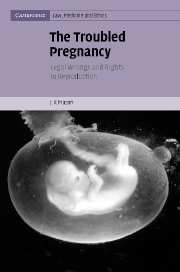Book contents
- Frontmatter
- Contents
- Preface
- Table of cases
- Table of statutes
- 1 The nature of the troubled pregnancy
- 2 Voluntary and involuntary termination of pregnancy
- 3 Antenatal care and the action for wrongful birth
- 4 Unsuccessful sterilisation
- 5 Uncovenanted pregnancy and disability
- 6 Wrongful neonatal life
- 7 The management of the disabled neonate
- 8 Conclusion
- Bibliography
- Index
3 - Antenatal care and the action for wrongful birth
Published online by Cambridge University Press: 19 July 2009
- Frontmatter
- Contents
- Preface
- Table of cases
- Table of statutes
- 1 The nature of the troubled pregnancy
- 2 Voluntary and involuntary termination of pregnancy
- 3 Antenatal care and the action for wrongful birth
- 4 Unsuccessful sterilisation
- 5 Uncovenanted pregnancy and disability
- 6 Wrongful neonatal life
- 7 The management of the disabled neonate
- 8 Conclusion
- Bibliography
- Index
Summary
Introduction
In the discussion of abortion that has gone before, I have deliberately avoided the fourth ground on which a legal termination can be founded. This is because the motivation of and the moral issues involved in that sub-section are of a very different type from those addressed in Chapter 2. The now relevant text of the 1967 Act, section 1(1), reads that a person shall not be guilty of an offence under the law relating to abortion if, again, two registered medical practitioners are of the opinion, formed in good faith:
(d) That there is a substantial risk that if the child were born it would suffer from such physical or mental abnormalities as to be seriously handicapped.
I have to admit that, at one time, I was prepared to suggest that, second only to the saving of the mother's life, this was the ground which was most likely to be widely acceptable. It will become clear in the following pages that I now consider that to have been an unjustifiable view.
As a start to the analysis, it is to be noted that no time limit is now imposed under the subsection. The practical reason underlying this relaxation is that the diagnosis of genetic or chromosomal disease is time consuming; given that the test may also have failed at the first attempt, it was more than possible that the conditions justifying lawful termination would be discovered only after remedial action in the form of abortion was rendered potentially illegal by virtue of the Infant Life (Preservation) Act 1929, section 1.
- Type
- Chapter
- Information
- The Troubled PregnancyLegal Wrongs and Rights in Reproduction, pp. 53 - 99Publisher: Cambridge University PressPrint publication year: 2007

